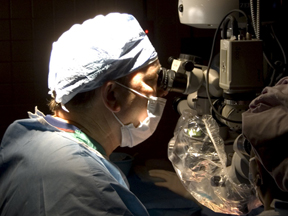Oran Almog’s journey to the UAB Callahan Eye Hospital at the University of Alabama at Birmingham began at a restaurant in Haifa, Israel. Ellen Bomer’s started at the U.S. embassy in Tanzania. Baljit Singh was in India. And Emily Lyons was on Birmingham’s Southside. Each suffered severe eye trauma and sought treatment at UAB, a world leader in eye care.
|
|
|
Download image. |
They certainly are not alone. Each year nearly 2,200 people are treated for eye trauma at the Eye Foundation Hospital, the nation’s first and only Level I ocular trauma center as designated by the American Society of Ocular Trauma.
“We’re writing the book on eye trauma here in Birmingham,” said Brian Spraberry, CEO of the Callahan Eye Foundation Hospital.
Eye trauma has many causes, from violence to accidents. More than 17,000 traumas were reported in the U.S. Eye Injury Registry between 1982 and 2010. More than half of those injuries were in people younger than 30. Sixty-five percent of injuries were unintentional, and 17 percent were caused by violence.
Almog was 10 when a terrorist’s bomb killed several family members and took his left eye and damaged his right. Bomer was the victim of a suicide bomber in the 1998 embassy attack that killed 11 people and injured 85 in Dar es Salaam.
Singh was a world-class field hockey player for the Indian national team when his eye was injured during a training exercise. Lyons was a victim of domestic terrorism, blinded when Eric Rudolph’s bomb blew up a Birmingham abortion clinic.
Each found their way to Birmingham and UAB, where damaged eyes often can be repaired using technology, skill and the will to try.
“The eye trauma surgeons at the Eye Foundation Hospital have developed unprecedented expertise through the volume of patients treated,” said Doug Witherspoon, M.D., director of the Ocular Trauma Center at the Eye Foundation Hospital. “New techniques and specialized tools have been created. Surgeons here have demonstrated that cases deemed hopeless by others may be at least partially repairable.”
“In many cases of eye trauma, our surgeons have been able to prevent total blindness and help patients regain some useful vision that will allow them to continue to live their lives as normally as possible,” said Spraberry.
Birmingham has put its stamp on eye care and eye trauma, in particular. The American Society of Ocular Trauma is headquartered here, as is the United States Eye Injury Registry and Helen Keller Foundation for Research and Education. The Birmingham-based EyeSight Foundation of Alabama and the International Retinal Research Foundation play major roles in funding vision research.
The Birmingham Eye Trauma Terminology System was developed here in 2002 to codify the terminology and better enable eye physicians worldwide to communicate without a language barrier. Next came the Ocular Trauma Scoring System, a method to predict visual outcome following eye trauma and identify the level of resources needed to treat it.
“The presence of so many highly regarded, vision-related organizations, coupled with the resources of the Eye Foundation Hospital and the outstanding ophthalmologists at UAB and within the community set the standard of eye-trauma care for the rest of the world,” said Spraberry.
Spraberry says one benefit of the Level I designation is that it will boost awareness among the public, first responders, paramedics and other medical professionals that Alabama has a world-class eye-trauma facility.
The American Society of Ocular Trauma Level I designation has several requirements:
-
Ocular trauma hospitals must have emergency services with nursing and physician staff on site 24 hours a day, seven days a week, and the ability to perform emergency surgery within one hour of admission.
-
The facility must have all necessary equipment, supplies, instruments and ancillary services to treat all types of eye trauma available around the clock.
-
Other medical specialties such as internal medicine or infectious diseases must be accessible within an hour.
-
Nursing staff must complete ophthalmic and eye-trauma-specific education requirements periodically.
-
Additional requirements include participating in research and education activities and serving as a community resource.
“Vision is precious, and eye trauma can be a devastating blow,” said Spraberry. “We want everyone in Alabama to know about the resources, skill and expertise in eye trauma that the Callahan Eye Foundation offers the community, state and region.

